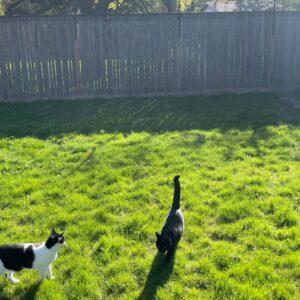Nature Canada and Partners Launch a New Cat Count Study in the City of Gatineau
Nature Canada is collaborating with the Club des Ornithologues de L’Outaouais (COO) to conduct a cat count pilot study in the City of Gatineau. The study is scheduled to start this spring, all things permitting.
This project has two objectives: first, to estimate the number of cats outdoors within the City of Gatineau or at least some of its sectors, and secondly, to develop a citizen science tool that can be used in other communities.
Nature Canada’s campaign to keep cats safe and save bird lives has been running since 2016. It’s now time to measure the progress that has been made towards our goal of reducing the number of cats outdoors. The outdoors is a hostile environment for cats, and can shorten their lives as they fall victim to vehicles, wildlife such as coyotes, or disease.
We also know that cats are extremely hard on wildlife. Environment and Climate Change Canada’s own scientists determined that cats in Canada kill between 100 million and 350 million birds each year. Our bird populations are already under a great deal of pressure. The threat they face by cats is something we can change.
A 2018 survey conducted by Nature Canada determined that as many as one quarter of Gatineau cat owners allow their pets to wander off property. Our upcoming study will determine the actual scale of this problem, and allow for a better understanding of the impact these cats are having on local wildlife.
How the Gatineau Study Will Work
The Gatineau pilot study uses methods developed by Dr. Elizabeth Gow from the University of Guelph. Part of Dr. Gow’s research focuses on improving cat and bird management to protect wild bird populations and reduce the threats faced by domestic cats. A similar, larger scale study is being implemented within the City of Vancouver over the next several months.
Surveying is done using trail cameras that capture action in a range of city habitats, including residential areas, industrial areas, institutional landscape, and parkland. In science, worthwhile results often depend on sample size—the variety of samples from which we can draw conclusions or estimate numbers.
For this study, that means deploying cameras for many days at several locations around the city. The cameras are positioned low to the ground in a secure location. Cats and other animals wander into the camera’s field of view. Their actions trigger the motion sensor and the camera snaps a photo of the critter in question.
Trail-cams have already been set up in residential backyards for the first month-long test phase of the study. These cameras are popular with hunters (they are called caméra de chasse in Quebec) and for general recreation, but they can also be used as an objective way of gathering information on nature.
Trail-cam photos will be analyzed to identify cats based on their markings. We expect our cameras to photograph other wildlife, too: the usual suspects of raccoons, squirrels, and skunks. Data can then be used to estimate the outdoor cat abundance in any one area, but will also provide a portrait of local wildlife. The cameras have an infrared capability and can also ‘capture’ movement at night when many mammals, including cats, are on the prowl.
This information is important to assess the effectiveness of city-wide policies to reduce roaming cat populations. The City of Gatineau has a bylaw that prohibits cat owners from allowing their pets to roam off property. Without monitoring, however, it is difficult to assess the effectiveness of that bylaw. This gathered data will establish a baseline figure against which to measure the success of efforts to reduce outdoor cat populations through education, bylaws, and other control measures such as sterilization campaigns for feral cats in the future.
The Gatineau pilot study will be conducted by a small group of citizen scientists. Each camera is supervised by a single individual, meaning the project can go forward even with physical distancing guidelines in place.
Our pilot study will surely produce some interesting photos and information. In the meantime, volunteers from COO have been testing the cameras around the Gatineau area—here’s what they are finding so far!









